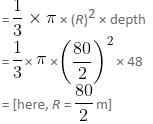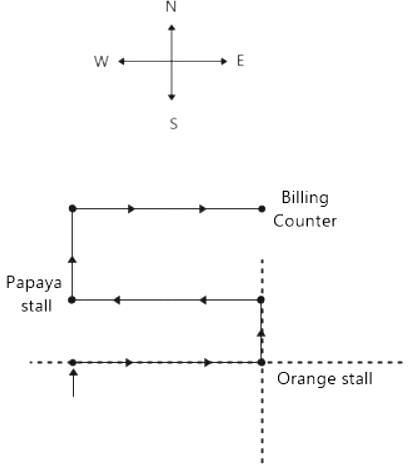SSC MTS Mock Test - 6 - SSC MTS / SSC GD MCQ
30 Questions MCQ Test - SSC MTS Mock Test - 6
Ajay and Vijay can do a piece of work in 28 days. With the help of Manoj, they can finish it in 21days. How long will Manoj take to finish the work all alone?
The number obtained by interchanging the two digits of a two digit number is less than the original number by 27. If the difference between the two digits of the number is 3, then what is the original number?
The HCF and LCM of two numbers is 84 and 840 respectively. If the first number is 168, find the second one
The marked price of an article is 20% higher than the cost price. A discount of 20% is given on the marked price. In this transaction the seller
If (a + b) : (b + c) : (c + a) = 6 : 7 : 8 and (a + b + c) = 14, then the value of c is
Find the approximate time taken to fill a chemical conical vessel, if the flow rate is 20 meters per minute from a cylindrical pipe whose diameter is 5 meters. Take diameter and depth of the conical vessel as 80 meters and 48 meters, respectively.
In this following question, four words have been given, out of which three are alike in some manner and the fourth one is different. Choose out the odd one out.
Directions to Solve
In each of the following questions find out the alternative which will replace the question mark.
Question -
ZRYQ : KCJB :: PWOV : ?
The rows and columns of the left matrix have been labelled as 5, 6, 7, 8, 9 and F, G, H, I, J, whereas those of the right matrix are 0, 1, 2, 3, 4 and K, L, M, N, O. Find the correct row-column pairs out of these matrices that decode to the word - NKS8
Two matrices are shown in the figure below. Their rows and columns are labelled as (0,1,2,3,4) and (5,6,7,8,9) in the manner shown. Find the correct row-column pairs out of the following matrices that decode to the word - EASY
Directions: Study the following information carefully and answer the given questions.
Virat goes to Supermarket store to buy fruits. He enters the market, turns to his right, walks 7m and takes oranges. Then, he turns to his left, walks 3m and takes Peach. Again, he turns to his left, which is towards west, walks 7m and takes Papayas. Again, he turns to his right and looks at guavas, which 8m away from him. He takes guavas and moves to his right, walks 7m and stops at the counter for billing.
Q. In which direction is the Papaya stall located with respect to the Orange stall?
Consider the following statements:
- The discussions in the Third Round Table Conference eventually led to the passing of the Government of India Act of 1935
- The government of India Act of 1935 provided for the establishment of an All India Federation to be based on a Union of the provinces of British India and the Princely States. Which of the statements given above is/are correct?
Tape recorder should not be kept near one of the following things –
Which national highway connects Delhi and Kolkata via Mathura and Varanasi?
The 'Atal Jyoti Yojana' recently seen in the news is related to:
Consider the following pairs with reference to various initiatives by Ministry of Agriculture & Farmer's Welfare: Mobile Apps/Portal Use
1. Kisan Rath : Facilitates transportation of food grains and perishables during COVID lockdown
2. Meghdoot : Provides crop and livestock-specific weather-based agro advisories to farmers
3. Krishi Megh : A Data recovery centre of Indian Council of Agricultural Research
Which of the pairs given above is/are correctly matched?
What was the main objective of the DPIIT's notification of Quality Control Orders (QCOs) on Potable Water Bottles & Flame-Producing Lighters?
What is the aim of the BHARAT campaign launched by Manoj Ahuja, Secretary of the Ministry of Agriculture & Farmers Welfare?
Which state recently launched the Mobile Dost App for mobile-based delivery of citizen-centric services?
Which country successfully launched the world's first methane-powered rocket to space?
Read the each sentence to find out whether there is any grammatical error in it. The error, if any will be in one part of the sentence. The letter of that part is the answer. If there is no error, the answer is 'D'. (Ignore the errors of punctuation, if any).
In the following questions four alternatives are given for the idiom/phrase italicised and underlined in the sentence. Choose the alternative which best expresses the meaning of idiom/phrase.
Q. He is leaving the country for good.
Each species has its special place or habitat. An (31)____ bird watcher can look at (32)____forest, meadow, lake , swamp or field and (33)____ almost exactly what birds he (34)____find there (35)____birds are found all over the world; others (36)____ themselves to certain areas. Still (37)____migrate from one country to another in (38)____in search of warmth and (39)____, and then return in spring,(40)____the season is more favourable.
Q. Find the word most appropriate for Blank No. 31
Each species has its special place or habitat. An (31)____ bird watcher can look at (32)____forest, meadow, lake , swamp or field and (33)____ almost exactly what birds he (34)____find there (35)____birds are found all over the world; others (36)____ themselves to certain areas. Still (37)____migrate from one country to another in (38)____in search of warmth and (39)____, and then return in spring,(40)____the season is more favourable.
Q. Find the word most appropriate for Blank No. 32


















